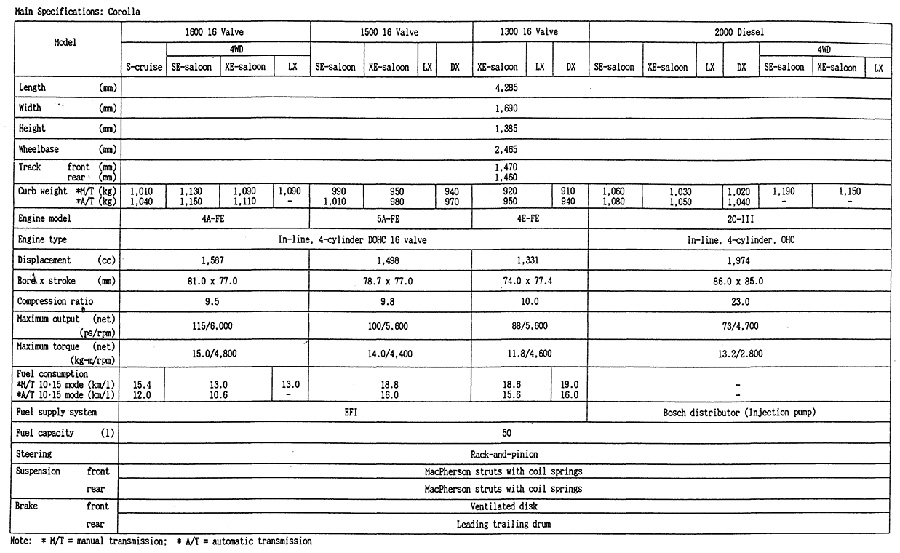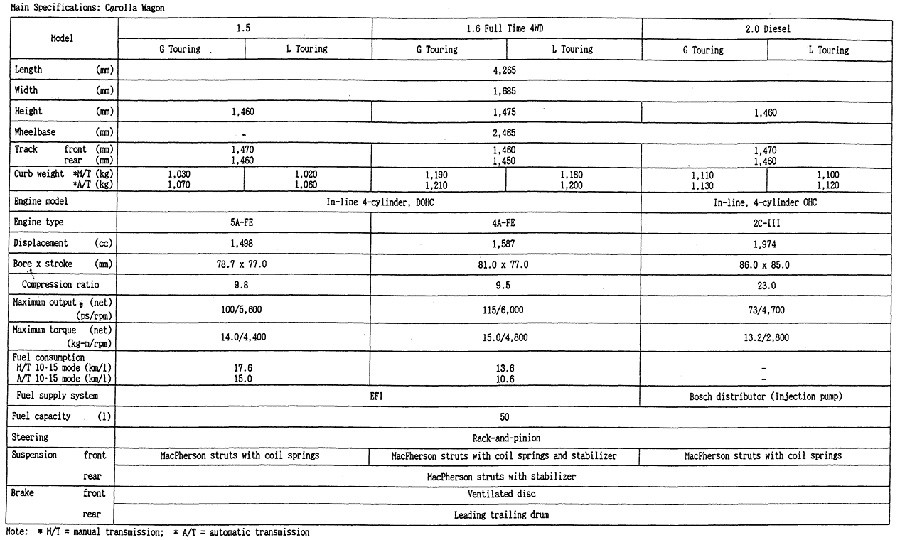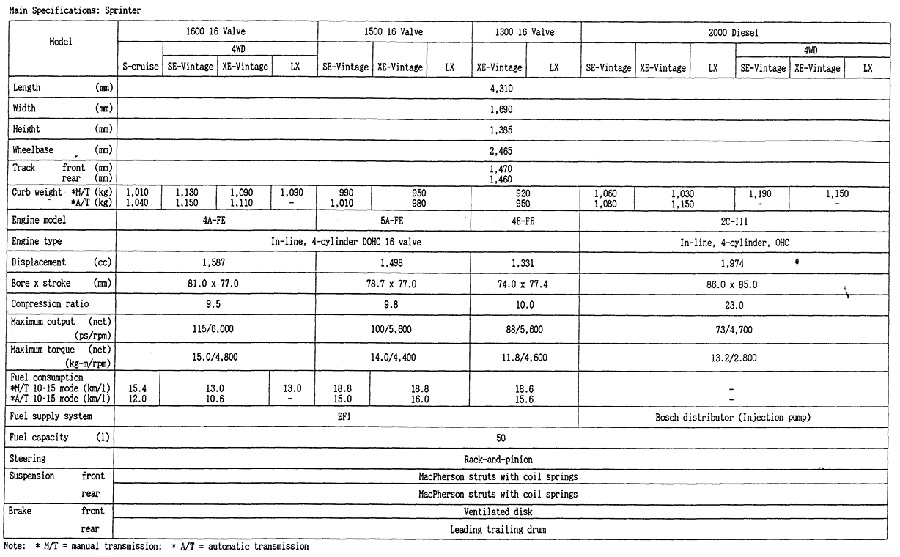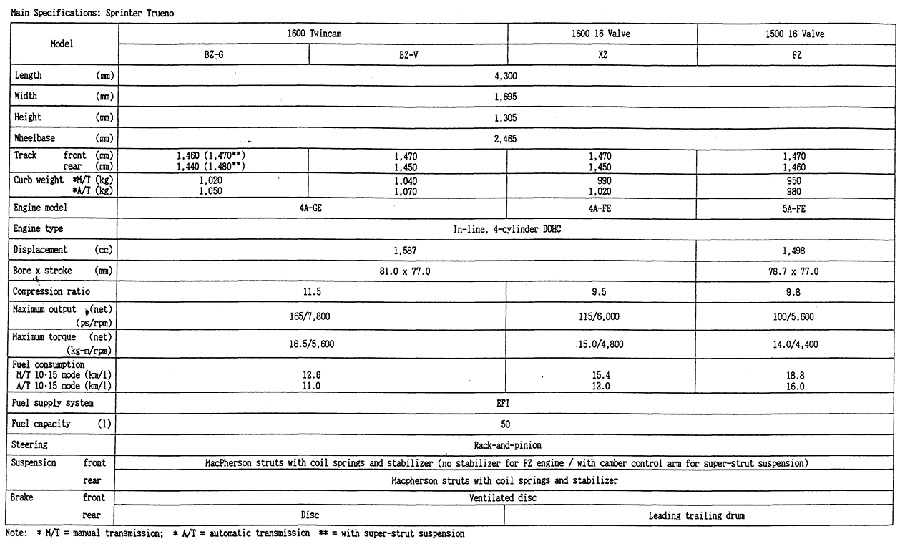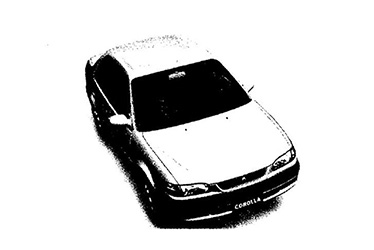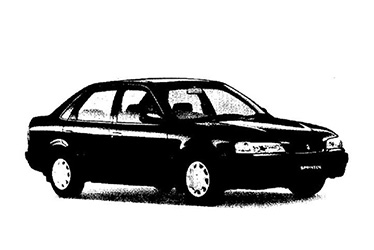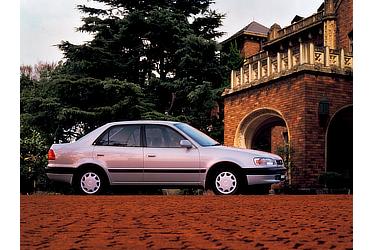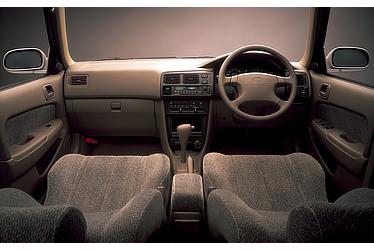May. 15, 1995
Toyota Introduces Full Model Changes for Corolla and Sprinter
Economic and Environment-Friendly Compact Cars
Tokyo―TOYOTA MOTOR CORPORATION today introduced the new-generation Corolla and Sprinter sedans and coupes―the Corolla Levin and Sprinter Trueno. Since the launch of the first Corolla and Sprinter models, they have set the standard for quality and performance in their class, and have proved extremely popular with the car-buying public.
The goal for remodeling the Corolla and Sprinter was to come up with the top compact car. These models both fully reflect the conservation of natural resources and enhanced safety features. The design was renewed maintaining the size and quality, and driving performance was enhanced while achieving attractive pricing and maintenance costs, outstanding fuel economy, and reliability.
Minor changes to the Corolla Wagon and improvements to the Corolla Ceres and Sprinter Marino hardtop models have also been introduced.
Principal Features of the New Models
- Weight reduction ensuring outstanding fuel economy, safety levels that are capable of meeting the latest U.S. standards, and higher environmental conservation standards.
- Sleek body design with a spacious cabin providing a comfortable, practical interior.
- Much improved driving performance and ride through the use of engines that match vehicle characteristics, lighter weight, and further refined chassis design.
- Superb value because of lower suggested retail prices for virtually all grades, plus low fuel and maintenance costs.
-
-

- Corolla Sedan
-
-
-

- Sprinter Sedan
-
-
-

- Corolla Levin
-
-
-

- Sprinter Trueno
-
- Overview
-
Environmental Considerations
Completely rethinking the materials used, structural design, and installation of the chassis, engine, and other components has reduced body weight by a maximum of 50kg for sedans and 70kg for coupes, thus achieving greater conservation of natural resources through fuel economy.The 1.3-liter and 1.5-liter high-efficiency twin-cam engine has been improved in detail, from fuel combustion and reduction of friction loss to lower idling speed.Together with the lighter weight and the rationalized body and chassis, the 1.5-liter 5A-FE engine with automatic transmission provides extraordinary fuel economy of 16.0km per liter (10•15-mode), making it among the best in its class.The 2.0-liter diesel engine meets the latest emission standards. Smoke and NOx emissions are significantly reduced thanks to the emission gas recirculation (EGR) device, which is now equipped for manual transmission cars as well, and changes have been made to the fuel injection pump.Highly recyclable Toyota Super Olefin Polymer has been used for the front and rear bumpers, and as interior material. The sedan bumper has a split structure whose top half is left unpainted because this area is most often damaged in collisions. Hence, repair costs are lowered and natural resources saved in the event of damage replacement.Along with other Toyota vehicles, resin scrap produced in manufacturing on all models is recycled and parts are labeled to identify resin materials. Ozone-friendly coolant is used for the air-conditioning system, and production methods use no CFCs. Also, only asbestos-free parts are used.Safety Consideration
Higher levels of both active and passive safety design have been incorporated into the new models.Active Safety
Edged profiles, both in the front and rear, increase driver visibility. Ergonomically designed switches and other controls have been set closer to the driver for easier operation. The seats have also been improved for better comfort and greater relaxation while driving. The significantly upgraded chassis delivers excellent drivability for avoiding emergencies better.Passive Safety
The crash impact-absorbing structure (CIAS) has been upgraded. The introduction of stronger cross members and other horizontal framework members and energy-absorbing doors has achieved levels meeting the new safety standards in Japan, as well as having the safety levels capable of meeting the new U.S. side-impact crash safety standards. The driver-side supplemental restraint system (SRS) air bag for minimizing injury in frontal collisions has been introduced as standard equipment for major grades, and as an option at affordable prices in other grades.Exterior
The sedans feature a more sophisticated and quality look with a roomy, functional cabin. The compact body enhances vehicle agility, and the split bumper makes repair easier.The Corolla has a sleek side silhouette, with the hood relief and trunk lid that assure greater visibility. The clean, functional grille and the rear combination lamps enhance the enduring and high-quality image.The Sprinter emphasizes a youthful, sporty look thanks to the stylish silhouette resulting from the six-light cabin and short deck, and the prominent grille and trapezoidal rear combination lamps.The coupes feature a compact and stylish design with sleek sash-less cabin, a sharp fender top line, and plain view tension toward front and rear. The Levin has an elegant and sporty look with the prominent grille, head lamps and linear rear combination lamps. The Trueno sports a grilleless design with graceful bumpers and smoke-lens rear combination lamps that create a youthful look.Interior
The sedans now have a broader and wider cabin for greater passenger convenience, and the bright interior colors above the belt line give the cabin a more airy, spacious feel.The instrument panel has been widened and refined, allowing larger, easier-to-read meters, and switches have been placed closer to the driver for better visibility and operability.The door trim has been designed to provide better safety in side collisions and better operability. The seats optimize pressure on them when occupied, and have an innovative cushion made with a newly developed high-elasticity, high-density urethane foam, providing better fit and hold to reduce fatigue over extended periods of driving.The coupe interior features novel and dynamic door trim, seats with broader shoulder support, and a lively cabin atmosphere.
A refreshing image has been created with blue and green accents on the seat cover (BZ grade). Small meter hoods and a horizontal cluster are designed for easier functioning. The look of the cockpit-like panel is enhanced by its lower position and sporty design.
- Performance
-
Engines have been selected for greater adaptability to the vehicle. With drastic weight reduction and a fine-tuned chassis, driving performance has been improved considerably for greater riding comfort.
Engines
Both the 1.3-liter 4E-FE and 1.5-liter 5A-FE high-efficiency twin-cam engines are equipped with an air intake system suited to normal driving conditions. Apart from increased maximum torque, low-end torque has been boosted for greater drivability in both city and highway conditions.Leading-edge technologies, such as variable valve timing (WT), continue to be applied to the sporty 20-valve, twin-cam 1.6-liter 4-cylinder 4A-GE engine mounted on the BZ-grade coupe. In addition, the intake/exhaust ports have been enlarged and the piston crown design has been optimized to increase maximum output and achieve smooth revving to high engine speeds.The two-way exhaust control system is realized with valves opening and closing in the muffler. Under normal driving conditions, valve closure reduces low-frequency noise, while in the high RPM range, valve opening reduces high-frequency noise and increases flow for greater output and noise control.Chassis
Apart from the change in the bush of the front lower arm and an upgraded power-steering gearbox, the chassis uses a new, lightweight, compact helical limited-slip differential (LSD) which better responds to accelerator operation. This is standard on manual transmission models with super-strut suspension and provides better handling performance.Body
With a refined body-frame design, increased strength of front suspension members and a change in the main muffler support structure, vibration and noise to the cabin have been minimized. Effective layout of noise-absorbent material has achieved greater noise control despite significantly reduced body weight.Outstanding Value
Efforts to achieve rational design and "simultaneous engineering" (where each division works on a project simultaneously and in coordination with other divisions throughout the project), have cut costs and reduced suggested retail prices for virtually all grades. Moreover, excellent fuel economy together with the durability and quality the cars inherit from their predecessors, improve the total cost of ownership.Minor Changes to the Corolla Wagon (Touring Models) and Improvements to the Corolla Ceres and Sprinter Marino Models
The Corolla Wagon now features full-time four-wheel drive (4WD), a diesel engine option, and a sporty grille design and color. Various dealer options, including large fog lamps, are available to satisfy customer preferences in model customizing.The Corolla Ceres and Sprinter Marino now feature the new, fresh silver and green colors. Engine and chassis improvements are similar to those for the sedans and coupes, and have enhanced basic performance considerably.
Sales Outline
- The Corolla is available at Toyota Corolla dealers nationwide, and the Sprinter is available at Toyota Auto dealers nationwide. Monthly sales targets are as follows
-
- Corolla Sedan
- 14,000 units
- Corolla Levin
- 3,500 units
- Sprinter Sedan
- 6,000 units
- Sprinter Trueno
- 1,500 units




